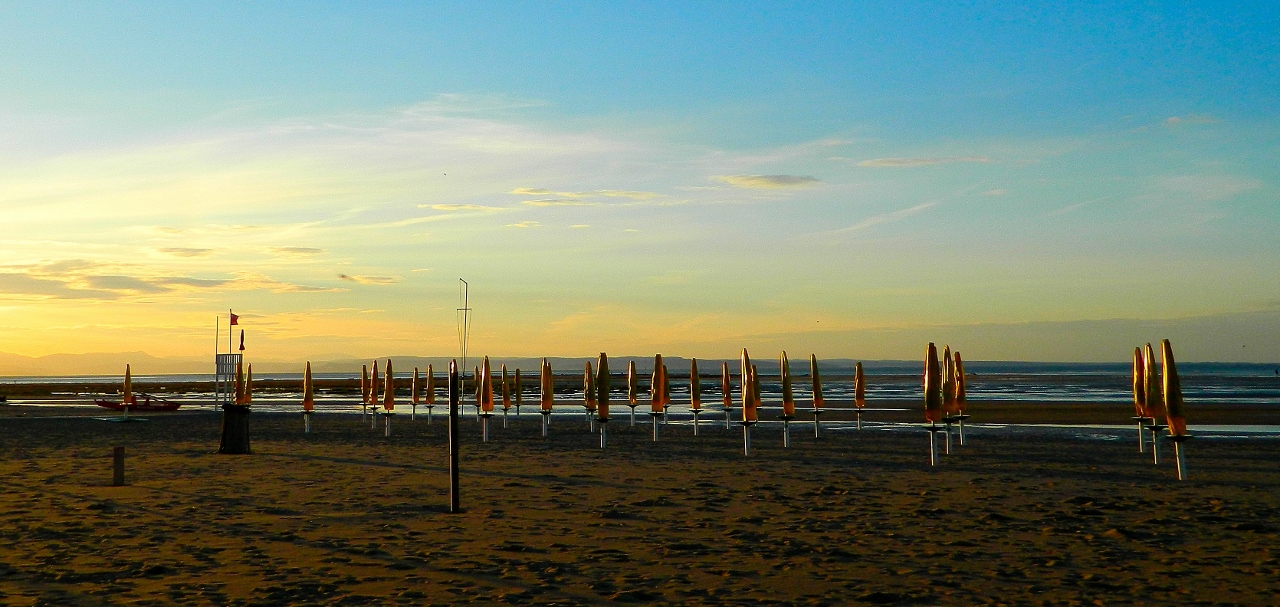We set off early for Italy and drove on the free local roads south west towards Trieste. A diversion caused us to cross a range of hills but it was enjoyable as the road wound up past farms and small holdings and fruit-laden trees. With the dusty old dame of Trieste in sight below we began a long, slow descent from the hillside to the Italian border.
Once over the other side the rural scenery immediately became Italian yew trees, high stone walls and villas with views of the Adriatic below.
Being Sunday morning, it was quiet on the roads around Trieste, and we made it quickly down to sea level and out onto the peninsula at Laguna di Marano. Driving across the marshy wetlands, we spotted storks, herons and lycra-clad cyclists enjoying the bright sunshine on the flat grassy plains. Where the land was arable, fields of golden corn were being harvested by farmers in small tractors. It was breezy and packs of seagulls wheeled dramatically above.
At the aire at Grado we had the choice of paying 16 euros to stay overnight and plug into electricity at one end of a large car park, or pay 4 euros for 24 hours parking next to fields and closer to the beach. We chose the latter and parked Bertha alongside eighty or so other vans, the most we’d seen in one place since leaving Budapest.
Grado is both a charming old town and a bustling beach-driven holiday resort. It was clearly closing for the season as labourers dismantled beach huts, decking and furniture – even digging out standing showers and boarding up public loos.
Unlike Croatia’s coast, which is all shingle or pebble, Grado is on a long sandy stretch of beach which grows by half a mile when the tide is out. Hopeful surfers stood around with body boards but the shallow waves were more fun for paddling children and dogs chasing balls.
Grado’s old town is a delight. We ventured in at lunchtime as the bells from its two Romanesque churches sent out the noontime peal. The interior of fourth century and dainty Santa Maria Delle Grazie is a showcase of Italian marble and stone.
Columned along both sides of the knave with pillars in grey and pink granite and white and black marble topped with carved stone capitals, it also has sections of original mosaic flooring. The ancient and hushed interior is captivating and it was interesting to see that the church proffered a general calm to others entering the doorway, similarly delighted by its charm.
A maze of narrow streets totter around the old town and worn stone steps lead up to battered wooden doors and balconies. Washing is hung out on lines strung above head level and bistro tables and chairs are squeezed into impossible corners for the sunshine and pretty views of shuttered houses.
In all of the small piazzas, tables were filling up with diners munching on gigantic plates of seafood and pasta and the air was heavy with the aromas of garlic, olive oil and cooked fish. The general happy chatter of Italian mixed with the sing song of waiters calling out orders. It felt good to be in Italy!
We cycled around the wetlands in the hope of seeing some wildlife, and a dome-topped basilica built on an island in the lagoon. Cycling along the flat roads was made challenging by a strong cross wind which almost sent my bike out from under me with every gust.
Sheltering in the wetlands, alongside the Canal di Marano, we disturbed a kingfisher. It flew alongside us for a while and I had to stop from shouting excitedly about its beautiful vermilion blue wings and burnt orange breast. It made the breathless bike ride worth every pedal!
We couldn’t reach the basilica by bike but saw it the next day when leaving Grado and crossing the long causeway over the laguna. Our route took us through Aquileia and without any prior knowledge of the town we were suddenly driving Bertha down the Roman columned way to the Forum. It was astonishing to see the standing pillars of pink marble and stone in their original positions on either side of the straight road.
Should we stay and explore? It was certainly tempting but we had set our sights on the tantalising destination of Verona, so marked Aquileia down as a town to hopefully return to on another day…
















